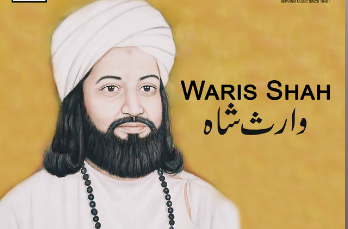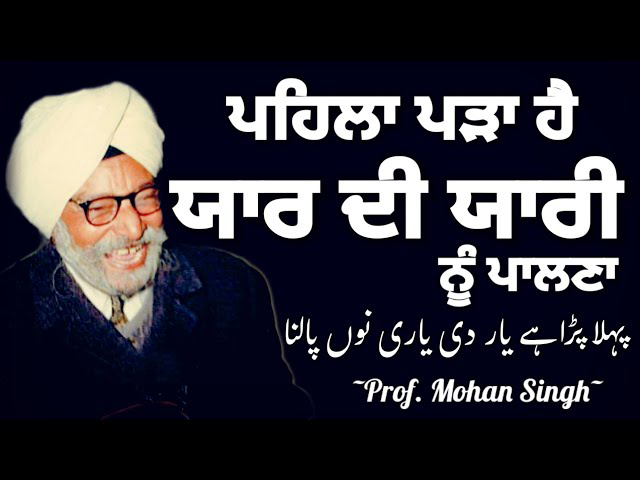Waris Shah: The Great Punjabi Poet and the Shakespeare of Punjabi Literature
Waris Shah, a revered figure in Punjabi literature, is best known for his epic poem Heer Ranjha, which remains one of the most celebrated and beloved pieces of Punjabi folklore. His contributions to Punjabi language and literature are profound, earning him a place of reverence not only in literary circles but also in the cultural consciousness of Punjab. This article delves into his life, works, cultural impact, and the legacy of his literary genius, often compared to Shakespeare for his insight into human nature and expression.
Early Life and Background
Waris Shah was born in 1722 in the village of Jandiala Sher Khan, located in the Sheikhupura district, now in Pakistan. His birth took place during a turbulent period in Indian history, under Mughal rule, characterized by political instability and cultural flux. Born into a well-educated Syed family, Waris Shah was steeped in Islamic teachings from a young age. His father, Syed Gul Sher Shah, was a scholar, which likely influenced Waris Shah’s intellectual development.
He pursued formal education in religious and secular studies, including Islamic law and Sufism, under the guidance of Makhdoom Sheikh Syed Mohyuddin at Kasur. This spiritual and scholarly foundation deeply influenced his poetic works, particularly his exploration of Sufism, philosophy, and human emotions.
Waris Shah’s Masterpiece: Heer Ranjha
Waris Shah is best known for his magnum opus, Heer Ranjha, which he completed in 1766. Heer Ranjha is a romantic epic based on the tragic love story of Heer and Ranjha, two star-crossed lovers from Punjab. The tale had been part of the Punjabi oral tradition for centuries, but Waris Shah’s rendition elevated the story to new heights, making it a timeless classic.
The Plot of Heer Ranjha
The story revolves around Heer, a beautiful and strong-willed woman, and Ranjha, a handsome young man. Despite their deep love for each other, societal pressures, familial obligations, and class divisions prevent them from uniting. After a series of trials, betrayals, and tragic circumstances, the lovers meet a sorrowful end, embodying the eternal struggle between love and society.
Themes in Heer Ranjha
Waris Shah’s Heer Ranjha is more than just a love story. It is a profound exploration of human emotions, societal norms, and spiritual teachings. Central themes of love, betrayal, class struggle, and the tension between individual desire and social conformity permeate the narrative. The poem also delves into Sufi mysticism, where love is portrayed as the highest form of devotion and a path to God. This spiritual layer adds depth to the romantic tale, making it a reflection of the soul’s longing for union with the divine.
Language and Style
One of Waris Shah’s most significant contributions to Punjabi literature is his use of the Punjabi language. He crafted Heer Ranjha in a way that resonated with both the elite and the common folk. His mastery of the language allowed him to infuse his verses with wit, wisdom, and philosophical depth. Waris Shah’s style is known for its simplicity, emotional richness, and the balance of poetic elements, making his work accessible yet intellectually stimulating.
His use of vivid metaphors, similes, and symbols reflects a deep understanding of the human condition, and his skillful portrayal of rural life in Punjab adds an authentic cultural dimension to his work. His dialogue-heavy narrative style also brings the characters to life, giving the poem a dramatic flair that has led many to compare him to Shakespeare.
Waris Shah’s Sufi Influence
Waris Shah’s works are deeply rooted in Sufi philosophy, a mystical branch of Islam that emphasizes the inward search for God and the idea of divine love. As a Sufi poet, Waris Shah used love as a metaphor for the soul’s yearning to be united with the Creator. In Heer Ranjha, this spiritual undertone is evident in Ranjha’s character, who is often depicted as a Sufi wanderer, seeking love not only in the form of Heer but also in a larger, existential sense.
The symbolism of love, separation, and reunion found in his poetry reflects core Sufi themes, where human love is a reflection of divine love. The trials and tribulations faced by Heer and Ranjha are metaphorical representations of the soul’s journey through the trials of worldly existence, striving to reunite with the Divine.
Waris Shah’s Cultural and Literary Impact
Waris Shah’s impact on Punjabi culture cannot be overstated. His Heer Ranjha became a cornerstone of Punjabi literature, influencing generations of poets, writers, and scholars. The tale of Heer and Ranjha, as narrated by Waris Shah, became deeply embedded in the cultural fabric of Punjab. It has been performed in various forms, including theater, music, and dance, and remains a favorite subject for Punjabi folk singers.
The universality of Waris Shah’s themes allowed Heer Ranjha to transcend regional boundaries, becoming part of the shared cultural heritage of both India and Pakistan. The story’s focus on human emotions and societal conflict resonated with people across different communities, making Waris Shah a symbol of the rich, shared cultural history of the subcontinent.
Influence on Punjabi Language
Waris Shah’s contribution to the Punjabi language is invaluable. He is credited with giving the language literary dignity and sophistication, making it a medium for high art and philosophical inquiry. His poetic style set a precedent for future Punjabi writers and poets, shaping the language’s literary tradition.
In the annals of Punjabi literature, Waris Shah’s Heer Ranjha stands as a benchmark of artistic excellence. His unique fusion of folk storytelling with deep philosophical insights helped define the distinct identity of Punjabi literature. His influence extends beyond poetry, impacting other forms of Punjabi expression, including prose and theater.
Legacy and Recognition
Waris Shah’s legacy lives on through his work, which continues to inspire readers and artists. His tomb in Jandiala Sher Khan remains a site of pilgrimage for lovers of poetry and Sufi devotees alike. His poetry, particularly Heer Ranjha, is frequently recited in gatherings, and various adaptations of his work continue to be staged in theaters across Punjab and beyond.
Waris Shah has been immortalized as one of the greatest poets of the Punjabi language. His ability to capture the complexity of human emotions, his profound spiritual insights, and his unmatched command of the Punjabi language have earned him the title of “Shakespeare of Punjabi literature.” Like Shakespeare, Waris Shah’s exploration of the human condition is timeless, making his works relevant to successive generations.
Commemorations
In recognition of his contributions, various cultural and literary festivals in Punjab celebrate Waris Shah’s works. His influence also extends into the academic realm, where scholars have studied his contributions to Punjabi literature, language, and culture.
Conclusion
Waris Shah remains one of the most towering figures in Punjabi literature. His masterful depiction of Heer Ranjha is not only a tribute to his poetic genius but also an enduring exploration of human love, societal structures, and spiritual longing. Through his work, he elevated the Punjabi language, giving it a unique voice in the broader landscape of South Asian literature. His poetry continues to resonate with readers, reflecting the universal human experiences of love, loss, and the search for meaning. For these reasons, Waris Shah’s legacy as a great poet of Punjabi culture remains eternal.





